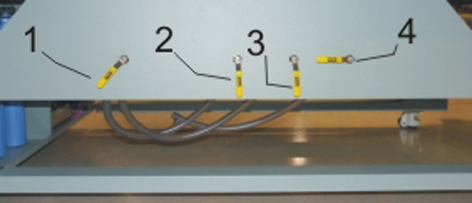

The Océ Arizona 365 GT uses a low-flow, high-vacuum system to secure rigid media for printing on the printer table. A fabricated aluminum overlay sheet placed on the surface of the table creates the vacuum field. The overlay sheet is pin-registered to the table. A rotary vane vacuum pump is used to evacuate the chamber of air between the sheet and the table. Three air-feed ports connect the chamber to the vacuum pump through a series of manually operated flow valves. These valves are used to activate or shut down the different vacuum zones. In order for the system to work effectively during printing all the circular pockets on the top surface of the overlay sheet connected to an active vacuum chamber must be covered. This creates a closed vacuum system. A bleed valve is provided to adjust the level of vacuum, if so desired.
Vacuum Overlay Sheet
The vacuum overlay sheet is supported on the table by 0.5mm diameter formed half-shear features. This produces a small gap between the sheet and the top of the table for air to flow. Foam tape applied around the perimeter of the sheet provides an edge seal. Additional foam tape can be used within the perimeter to create up to three custom vacuum zones. The 0.5mm diameter half-shear feature creates the equivalent of a counter-bored hole or circular pocket on the top surface of the panel. Each of these pockets is connected to the sealed underside of the panel by 1.5mm diameter punched holes.
Default Vacuum Zones
The printer is shipped from the factory configured with one large vacuum zone that accommodates the maximum media size. There are two suggested custom vacuum zone configurations, one for Metric and one for Imperial units. These zones can be set up for common media sizes, and can be modified with additional foam tape. The next section has more information on how to create custom zones.
|
1 - Bleed Valve partly open |
2 - Left Zone is Open |
|
||

|
||||
|
|
3 - Top Zone is Open |
4 - Right Zone is Closed |
|
|
These controls are meant for use with custom vacuum zones. If you only use the factory default of one large zone, make sure all three handles are left in the open position. When you create custom zones the three control valves are used to control which zones of the printer table will have vacuum applied when the table vacuum pump is turned on. To close a zone turn the control handle a quarter turn clockwise.
The vacuum foot pedal toggles the table vacuum on or off. It helps the operator to secure the media on the vacuum table since it allows hands-free operation. The vacuum must be turned on prior to starting a print, and the vacuum cannot be turned off until a print is completed.
The bleed valve handle is located to the left of the vacuum control handles. This bleed valve can be adjusted to control the amount of vacuum suction on the media. Less suction reduces artifacts caused by the suction when imaging on flexible media. If you see dimples on the media that are the same size and location as the vacuum table punched holes, introduce bleed until the dimples disappear from the media.
The bleed valve is off when its handle is in the horizontal position. To activate the bleed valve, turn the handle to the vertical position. The closer the handle is to the vertical position, the more vacuum pressure is reduced. The gauge on the side of the table above the bleed valve handle provides a visual representation of the actual vacuum pressure.
If an overlay sheet is damaged, replace it. The overlay is an optional commercial item and can be ordered from your local sales representative. You may want to purchase multiple overlays if you need multiple common material sizes or a regular, repeating job that is non-square or unusually sized.
If ink build-up occurs on the overlay sheet, remove the ink. If it is not removed, the print gap could be affected and this may affect the vacuum table's ability to secure the media properly. To remove ink we recommend that you use a paint scraper containing a straight edge razor blade (these can be found at a local hardware store). Refer to the Maintenance section for more detailed instructions.